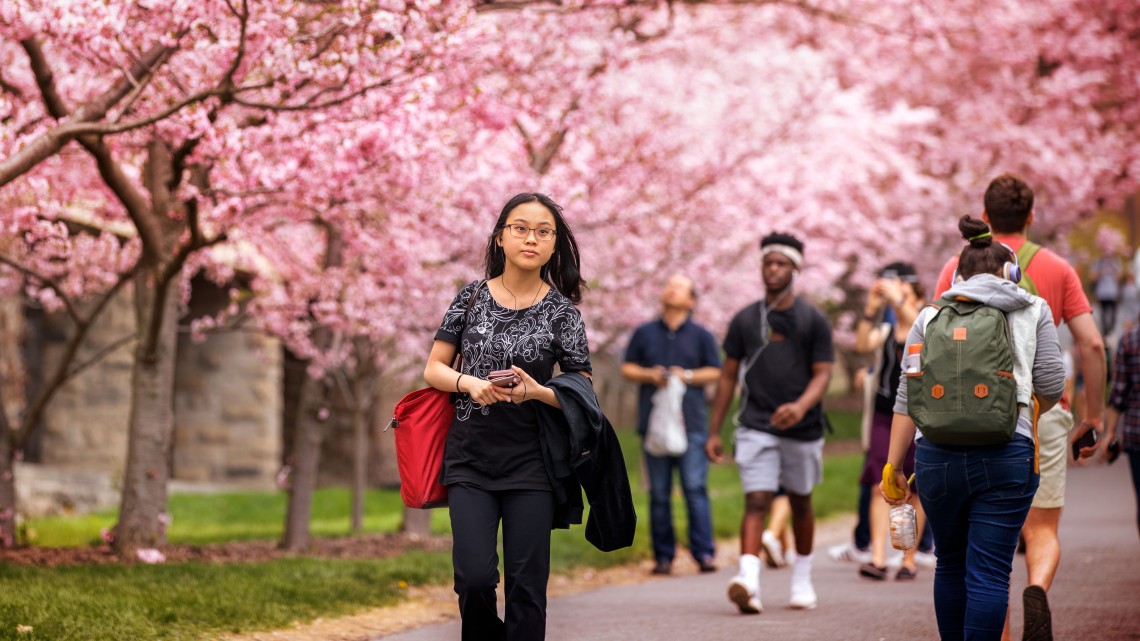
Students on campus in spring 2019.
Vice Provost Jonathan Burdick on attracting great students
By Joe Wilensky
Jonathan Burdick is Cornell’s vice provost for enrollment, overseeing admissions, financial aid and the university registrar’s office. He is charged with strategically positioning the university to achieve its institutional goals and priorities, while supporting and strengthening specific enrollment-related needs and goals of the colleges and schools. The position was created in 2018; Burdick has served in the role since August 2019. Previously he served as vice provost for enrollment initiatives and dean of admissions and financial aid at the University of Rochester, and associate dean for admissions at the University of Southern California.
How had your experiences at Rochester and USC prepared you for this position and what excites you about it?
Jonathan Burdick: USC has some similarities to Cornell in terms of its scale and complexity, and the University of Rochester is a bigger place than people realize in part because it’s a vast hospital system with a university attached.
When the Cornell position came up, I thought it really fit the two halves of my career and would be an interesting and exciting new challenge. Admissions and financial aid have long been linked together, and I’m blending all the things I learned in my previous positions.
My team is looking at issues that are universal across enrollment, like communications and marketing, as well as technology. We’ve also created a new office of enrollment compliance, which is important for our state and federal relationships.
One new dimension is that I have a direct-line reporting relationship from enrollment leaders in each of the colleges and schools. We’re all connected … and rowing in the same direction.
What defines a “comprehensive enrollment strategy”?
Right now, budget planning at Cornell goes on a 10-year time frame, and that includes trying to plan enrollment activity because tuition is a part of what drives our budget. But we haven’t had a 10-year enrollment plan before. I want us to be thoughtful about this: How many students are coming in as first-year students in the fall? How many, if any, will start in the spring? How many transfer students should we expect? And where are they coming from?
If we have that planning in place, then the colleges and schools and our entire marketing operation can gear up for multi-year activity. For example, a transfer student or a veteran begins to look our way sometimes two and three years before they get here; high school students often start to look in the summer after their sophomore years.
So in a sense, our audience is thinking more long term than we are about coming here. So how do we reach them? We need to integrate all of that.
Cornell has grown over the last 10 to 15 years. With the new housing being built on North Campus, there’s an opportunity to grow academic programs with new faculty, new facilities, [and] add more students. It’s not a zero-sum game, where the plan for growth in one area must come from somewhere else.
How difficult is it to balance the university’s overall goals and priorities through enrollment and financial aid with those of the individual colleges and schools?
One thing that I have found so appealing and so important is that every school and college cares about the same things. There’s a continuous spectrum of great students coming to Cornell through all these different portals. We’re more alike than we are different in all our colleges, and it is proving easy to get people to enjoy planning together instead of all planning separately.
The colleges define what their academic offerings are and what their faculty care about; that’s on the front end. On the back end, the colleges will continue to look at the applications that are coming their way and choose which students seem to fit best – for their college ethos, for their specific majors and for all the skills that they need.
Then there’s the middle ground, where we intersect with high school students and their advocates, and with parents and those audiences, where I want to get greater alignment and present us as one Cornell – this glorious place with all these amazing choices.
Is Cornell truly “need blind,” and what does that mean?
Yes – we’re need blind in the formal and correct sense that application readers do not know what a family’s need is.
We want the Cornell student population to be socially and economically diverse. This is central to our founding mission and the foundation for crucial 21st-century skills. There’s universal interest and appetite for that.
There’s a legitimate interest across all the colleges in identifying students who have achieved a great deal with what appears to be very little. That appeals to admissions readers, and they have the freedom to say, “I’m not worried about whether this student and their family can pay zero or $75,000; I’m advocating for this student.” So that’s good.
The best Cornell students will have things going on in their lives and things they’re ready to contribute beyond just being academically powerful. And so it’s a really important conversation that you have to get straight everywhere. Standards are critical and have to be real. And then there are the choices we have to make to select beyond the 90% of Cornell applicants who meet those standards. How do you look at a file and determine whether someone has grit or an open mind?
We also are planning for new financial aid policies that will make extra efforts to help students from middle-income families so they can choose Cornell, too. While the university has put a lot of resources behind admitting talented low-income students, we will be expanding efforts to assist more of those middle-income students; many of them express anxiety about their ability to pay.
How important is it to connect our admissions and enrollment strategy to graduation outcomes?
We have a very high graduation rate, and that’s always going to be true, because we are selecting students who are motivated, capable and performing at high levels. I would broaden that metric beyond just a graduation rate, beyond even graduating with positive outcomes, such as having jobs or going on to grad school.
Graduating satisfied – satisfied with your experience, satisfied with your peers, feeling a sense of connection and place – that’s the most important metric. It’s measurable; we survey our graduating students. And if we find deficits or issues there, then that is what we have to tackle. We want to make sure people not only have a successful Cornell experience in the narrowest terms, but also in the broadest terms.
The spring semester was interrupted in an unprecedented way by the ongoing coronavirus (COVID-19) outbreak that has affected millions around the world. We hope that we all will weather this pandemic by minimizing its spread and being able to get back to the business of research and teaching as soon as is feasible. How are we connecting our new class of admitted students with the campus community?
I’m impressed and grateful to be learning every day about the depths and talents of the Cornell staff. The response to this crisis, led by the leaders in admissions, financial aid and among the registrars, has been inspiring to watch.
We’ve had to redesign the academic calendar and figure out how to comply with changing regulations to pay our work-study students on the fly, and the effort and pace of our response has exceeded my imagination. People have worked through the nights and weekends to take care of students.
That’s no less true in our plans for outreach to the newly admitted students, and even to the high school sophomores and juniors beyond. For some of our admissions “extroverts,” losing Cornell Days is like losing their right arm! But they’ve stepped up and stepped in to create online content: chats, video, virtual tours and talks, blogs and ramped up Q&A offerings. I’m confident that Cornell has made a meaningful response that should help students choose to be here as soon as they can.
Colleges and universities across the country had to transition quickly to virtual and online learning for the balance of the spring semester in response to the COVID-19 outbreak. With university life ideally returning to something approaching normal this fall, can you make a renewed case for the residential college experience?
I think we should aim to reap all of the learning we’re doing right now by observing, albeit under duress, what is and isn’t great about online learning, and putting those observations to excellent use by both improving and framing future online learning.
We can, at the same time, understand afresh what we should value most about opportunities to share physical spaces as well as to communicate across virtual spaces. It’s counterintuitive right now, but the long-term outcome could well be that some of our virtual habits decline after this, as people hunger again for exchanging meaning with another person’s unpixelated face rather than the phone in their hand.
I also think there are big clues about the future of residential colleges to observe in considering what things were canceled rather than just transferred to a new format: We’re not playing virtual hockey or running virtual races. There are distinct limits to the value of mounting a theatrical production with the actors’ faces appearing on 12 little tiles, rather than reacting to each other on a common stage.
What I mostly expect we’ll remember and value are the casual, unpredictable encounters that happen on a residential campus – meeting someone you don’t know and didn’t expect to see, and getting to know them in casual ways. We can forget sometimes that being with other people is not only a method of sharing knowledge, but a joy, and that what is best in life is often not planned, but spontaneous.
Media Contact
Get Cornell news delivered right to your inbox.
Subscribe


